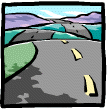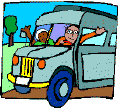 |
|
 |
|
|
 |
|
 |
| Ups n' downs?
Life? Elevators? Auntie Mame? Green Acres? How
'bout "Wolf Creek Pass"? There's a country song about that
where Earl comments "My...ain't this purty up here?" Purty?
You betcha - and deadly!
Whoa, hoss. Back up a little. How'd we get up here anyway? And where is Wolf Creek Pass? Ever been to Colorado? Wolf Creek Pass is on U.S. Highway 160 between South Fork and Pagosa Springs, not far from New Mexico and - oh yeah - over 10,000 feet. We got five, six, and seven percent grades, warning signs, speed limits, 30 MPH curves, one tunnel, and two truck escape ramps! For someone driving a car, all that doesn't mean a whole lot. But what if you're driving (or towing) an RV? Everything's changed and there's a whole new set of rules. Hmmm...wonder where we've heard that before? To quote an unknown author (probably an ol' truck driver), "You can go down a mountain too slowly a thousand times, but too fast only once." Think about it. Gettin' up that mountain poses no major problem if you've enough power and your cooling system is in good shape. Of course, turbos and efficient exhaust systems may help. But what about gettin' back down? I don't intend to scare ya' into not goin' where you please, but I do want you to make sure your equipment is in good shape before you go. Check those brakes - ALL of them. Are they in good condition and, more importantly, properly adjusted? If they are, that's fine, but use your engine and transmission to keep your speed under control whenever possible. Some aftermarket devices such as exhaust brakes and gear splitters or auxiliary transmissions may help. Save your brakes and keep them cool enough to retain their stopping power. Remember, the important thing is NOT how much you can pull, but how much you can stop! Overheated brakes are of no earthly use whatsoever. "Well, how can I prevent my brakes from overheating?" you ask. Yeah, I know. You've heard it all before. "Don't pump the brakes; don't ride the brakes; step on 'em hard to slow down, then let 'em cool." Riiiight. The best answer to your question is: Don't use 'em...except to stop...completely. If you need to use those brakes, find a wide spot and pull over. And now that you're stopped, relax, take a nap, have a cup of coffee, unwind and calm those frayed nerves. Just let those brakes cool off. Allow enough time so that you can place your hand on any of the rig's wheels without burnin' yourself. The wheels should be comfortable to the touch, not hot. The main ingredients involved in overheated brakes are the length of the grade, the steepness of the grade, the weight of the vehicle, and speed. Reducing any of these variables will greatly improve your chances of getting down the mountain without overheating those brakes. Most of the time, about the only thing that you, the driver, can change is speed, and reducing your speed may very well keep you and your family alive. 'Nuff said. See ya' down the road... "Honey, hand me the Mountain Directory, will you please?" |